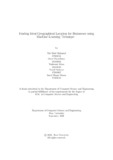| dc.contributor.advisor | Ashraf, Faisal Bin | |
| dc.contributor.author | Mahmud, Mir Ibtid | |
| dc.contributor.author | Chowdhury, Onez | |
| dc.contributor.author | Alvee, Yashwant | |
| dc.contributor.author | Sadman, Tawsif | |
| dc.contributor.author | Shaon, Imrul Haque | |
| dc.date.accessioned | 2022-01-11T05:02:57Z | |
| dc.date.available | 2022-01-11T05:02:57Z | |
| dc.date.copyright | 2021 | |
| dc.date.issued | 2021-09 | |
| dc.identifier.other | ID 17101351 | |
| dc.identifier.other | ID 21341063 | |
| dc.identifier.other | ID 16341010 | |
| dc.identifier.other | ID 17101107 | |
| dc.identifier.other | ID 17301045 | |
| dc.identifier.uri | http://hdl.handle.net/10361/15860 | |
| dc.description | This thesis is submitted in partial fulfillment of the requirements for the degree of Bachelor of Science in Computer Science and Engineering, 2021. | en_US |
| dc.description | Cataloged from PDF version of thesis. | |
| dc.description | Includes bibliographical references (pages 43-44). | |
| dc.description.abstract | The world has become a place where the economy is at the epicenter of it all. World
economic growth has paved the way for people to enrich their lives with all sorts
of blessings. A major chunk of this shift in the world's treasury all comes from
the tireless endeavors of a uent and
ourishing businesses. The more a business
thrives, the more economic sustainability it brings upon the society. And one of
the key factors of building up a thriving business is what motivated us to forgo
on our research. Location analytics in recent times plays an important role in
making a sustainable and pro table business. Very often trade and commerce rely on
uninformed struggles to analyze the perfect location for their establishment. Hence,
we used unsupervised learning to evaluate a dataset and create a decision making
model to accurately investigate whether a location will be be tting for a particular
business model based on customer behaviour and interests. As such we built a
dataset concentrating on questionnaire responses taken via online survey and tested
our model on the gathered data. We exercised the analyzed dataset in di erent
clustering algorithms such as kmeans, minibatch kmeans and hierarchical clustering.
Finally, using a decision tree model, we were able to extract an explanatory rule in
terms of quantitative values, which were further discerned in making an elaborate
assumption. Hence, based on consumer habits and interests, we concluded that
we could analyze which location or marketplace would be better suited for which
accessories a seller is selling, and hence suggest the perfect location for his business
to thrive upon. | en_US |
| dc.description.statementofresponsibility | Mir Ibtid Mahmud | |
| dc.description.statementofresponsibility | Onez Chowdhury | |
| dc.description.statementofresponsibility | Yashwant Alvee | |
| dc.description.statementofresponsibility | Tawsif Sadman | |
| dc.description.statementofresponsibility | Imrul Haque Shaon | |
| dc.format.extent | 44 pages | |
| dc.language.iso | en | en_US |
| dc.publisher | Brac University | en_US |
| dc.rights | Brac University theses are protected by copyright. They may be viewed from this source for any purpose, but reproduction or distribution in any format is prohibited without written permission. | |
| dc.subject | Data analysis | en_US |
| dc.subject | Geo analytics | en_US |
| dc.subject | Decision tree | en_US |
| dc.subject | Linear regression analysis | en_US |
| dc.subject | K-Means clustering | en_US |
| dc.subject.lcsh | Machine learning | |
| dc.title | Finding ideal geographical location for businesses using machine learning technique | en_US |
| dc.type | Thesis | en_US |
| dc.contributor.department | Department of Computer Science and Engineering, Brac University | |
| dc.description.degree | B. Computer Science | |

